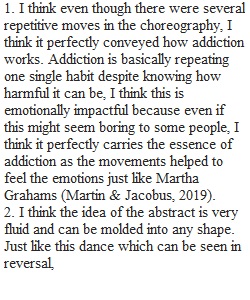


Q The Revelatory Capacity of Dance using Interpretive Criticism This clip is from Season 5 of the TV reality series So You Think You Can Dance. Emmy-winning choreographer Mia Michaels created this dance to express the complicated and terrifying relationship between an addict and his/her addiction—alcohol, drugs, gambling, eating, anger or whatever. The girl dancer, Kayla, is the addict trying to escape the powerful hold of her unnamed addiction. The addiction itself is represented by the boy dancer, Kupono. The song, "Gravity," is by Sara Bareilles. To complete this assignment, you must first watch the YouTube video, "Addiction (Gravity)” Click on it at the beginning of the first paragraph above, "This clip." After watching the video, number (1, 2, 3, 4) and answer each of the following discussion questions: 1) While watching the dance, were you aware of any repetitions of movements? You might want to watch the video again to see if repetition did or did not occur. If you saw repetitions, what effect did that have on your understanding of the movements of the dance? Was there too much repetition, which might make the dance a bit boring? Or was there not enough repetition, making the dance confusing or hard to follow? Did there seem to be an effort to balance repetition with contrast? 2) In a sense, this dance could be seen as a reversal of the paradigm set forth in Chapter 2, because an abstract concept---addiction—is made more concrete and understandable through the artistic form. In other words, the normal progression of concrete subject matter > artistic form > abstract content might be somewhat reversed in this work of art. Do you think so? Why or why not? How does this happen, in your opinion? 3) Perhaps you've been blessed by never having been trapped in an addiction. Perhaps you're struggling with one right now. In any case, you probably know something about addictions from reading, television, or the personal experiences of friends or relatives. How does the interaction between the dancers relate to what you know about addictions? 4) After watching this video and interpreting this dance, did you feel that you had more insight into the subject of addiction? If so, what do you feel you may have learned or understood by watching the dance? Or, conversely, did the dance have a negative effect on you, and if so, why? Remember, your participation and response should clearly reflect your reading and understanding of the chapter and specific content in this session.
View Related Questions